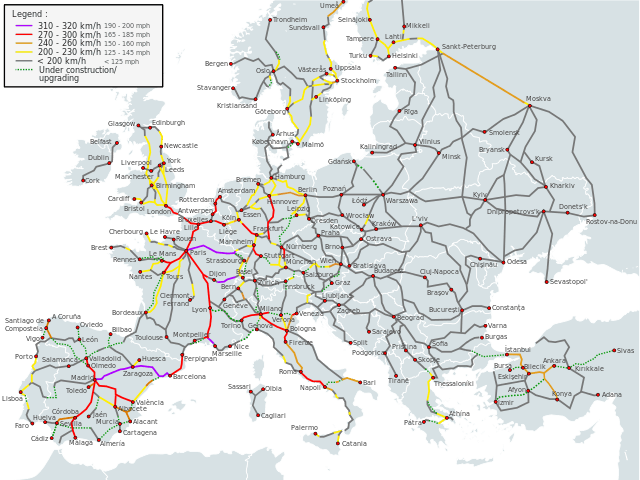Rail transport in Europe
Rail transport in Europe is characterised by its diversity, both technical and infrastructural.
Rail networks in Western and Central Europe are often well maintained and well developed, whilst Eastern and Southern Europe often have less coverage and infrastructure problems. Electrified railway networks operate at a plethora of different voltages AC and DC varying from 750 to 25,000 volts, and signalling systems vary from country to country, hindering cross-border traffic.
The European Union aims to make cross-border operations easier as well as to introduce competition to national rail networks. EU member states were able to separate the provision of transport services and the management of the infrastructure by Directive 91/440/EEC. Usually, national railway companies were split to separate divisions or independent companies for infrastructure, passenger and freight operations. The passenger operations may be further divided to long-distance and regional services, because regional services often operate under public service obligations, while long-distance services usually operate without subsidies.
Differences between countries

While most railways in Europe use 1,435 mm (4 ft 8 1⁄2 in) standard gauge, in some other countries, like Spain or countries which territories used to be a part of Russian Empire and Soviet Union, widespread broad gauge exists. For instance in Spain it is 1,668 mm (5 ft 5 21⁄32 in) (also known as Iberian gauge), while in Russia, Ukraine, Belarus, Finland, Baltic states gauge width is 1,520 mm (4 ft 11 27⁄32 in) or 1,524 mm (5 ft) (also known as Russian gauge). The reason different track gauges between countries was mainly because of the idea of preventing trains running on "your" track from a competing country. Likewise, electrification of lines varies between countries. 15 kV AC has been used in Germany, Austria, Switzerland, Norway and Sweden since 1912, while the Netherlands uses 1500 V DC, France uses 1500 V DC and 25 kV AC, and so on. All this makes the construction of truly pan-European vehicles a challenging task and, until recent developments in locomotive construction, was mostly ruled out as being impractical and too expensive.
The development of an integrated European high-speed rail network is overcoming some of these differences. All high-speed lines outside of Russia, including those built in Spain and Portugal, use 1,435 mm (4 ft 8 1⁄2 in) standard gauge tracks. Likewise all European high-speed lines, outside of Germany and Austria, use 25 kV AC electrification. This means that by 2020 high-speed trains can travel from Italy to England, or Portugal to the Netherlands without the need for multi-voltage systems.
Multiple incompatible signalling systems are another barrier to interoperability. The EU countries have 19 different signalling systems. A unified signalling system, ETCS is the EU's project to unify signalling across Europe. The specification was written in 1996 in response to EU Directive 96/48/EC. ETCS is developed as part of the European Rail Traffic Management System (ERTMS) initiative, and is being tested by multiple Railway companies since 1999. All new high-speed lines and freight main lines funded partially by the EU are required to use level 1 or level 2 ETCS signalling.
Cross-border operation

The main international trains operating in Europe are:
- InterCityExpress (Germany, The Netherlands, Belgium, France, Denmark, Switzerland and Austria)
- Thalys (France, Germany, Belgium, The Netherlands)
- Enterprise (Republic of Ireland & Northern Ireland (UK))
- Eurostar (Great Britain, France, Belgium)
- EuroCity/EuroNight (conventional trains operated by nearly all Western and Central European operators, with the notable exception of the United Kingdom and Ireland)
- TGV (France, Belgium, Italy, Switzerland, Germany, Luxembourg)
- CNL (Germany, Italy, Austria, Switzerland, France, Denmark, Czech Republic)
- Elipsos (France, Spain)
- Trenhotel (France, Spain, Portugal)
- Oresundtrain (Denmark, Sweden)
- SJ 2000 (Sweden, Denmark)
- Railjet (Austria, Germany, Switzerland, Hungary, Czech Republic by 2014)
Additionally, there are a lot of cross-border trains at the local level. Some local lines, like the Gronau to Enschede line between Germany and the Netherlands, operate on the signalling system of the country the line originates from, with no connection to the other country's network, whilst other train services like the Saarbahn between Germany and France use specially equipped vehicles that have a certificate to run on both networks. When there is an electrification difference between two countries, border stations with switchable overhead lines are used. Venlo railway station in the Netherlands is one such example, the overhead on the tracks can be switched between the Dutch 1500 V DC and the German 15 kV AC, which means a change of traction (or reconfiguring a multiple-voltage vehicle) is necessary at the station.

Harmonising rules
- First Railway Package (EU Directive 91/440)
- Second Railway Package
- Third railway package
- Fourth railway package
- European Rail Traffic Management System on harmonised signalling systems, to allow more cross-border trains
- Trans-European conventional rail network
- Single European Railway Area
See also
- Eurail Pass
- High-speed rail in Europe
- Interrail Pass
- Trans Europ Express
- Channel Tunnel
- List of highest railways in Europe
External links
- Council Directive 91/440/EEC of 29 July 1991 on the development of the Community's railways
- Council Directive 96/48/EC of 23 July 1996 on the interoperability of the trans-European high-speed rail system
- Maps of railway networks in Europe
- Level of service on passenger railway connections between European metropolises Report of the Transport and Spatial Planning Institute
- Eurail map
References
| ||||||||||||||||||